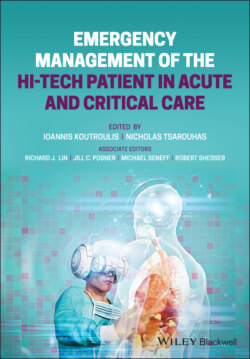Читать книгу Emergency Management of the Hi-Tech Patient in Acute and Critical Care - Группа авторов - Страница 62
Introduction
ОглавлениеThe hepatic portal system is a group of vessels that supply nutrient‐rich blood from the gastrointestinal tract to the liver. The hepatic portal vein drains the superior mesenteric vein and the splenic vein, as well as receives blood from the inferior mesenteric, gastric, and cystic veins. Within the liver, the portal vein branches to right and left, dividing further into portal venules. Portal venules and hepatic arterioles empty into hepatic sinusoids where hepatocytes receive nutrients, process toxins, and mix oxygenated blood. After processing, blood is returned to the systemic circulation via the hepatic vein.
Portal hypertension exists when the pressure in the portal venous system of the liver exceeds 10 mmHg. There are myriad causes of portal hypertension, which are broken down to three categories. Presinusoidal causes affect the portal vein and venous system. Portal vein thrombosis may be related to hypercoagulable states, or in neonates, a complication of umbilical central venous access. Direct mass effect or invasion of intrahepatic tumor may cause obstruction. Schistosomiasis causes fibrosis within the portal venules prior to the sinusoids. Other etiologies prior to sinusoids include hepatic fibrosis, congenital extrahepatic portal vein occlusion, arterioportovenous fistulae (Osler–Weber–Rendu syndrome), and hyperdynamic splenomegaly. Etiologies affecting the sinusoids (sinusoidal causes) include cirrhosis, congenital hepatic fibrosis, cystic liver disease, sclerosing cholangitis, and primary biliary cirrhosis. Cirrhosis is the most common cause of portal hypertension and may be related to viral hepatitis or alcoholic cirrhosis. Less commonly, Wilson's disease and hemochromatosis may lead to sinusoidal fibrosis and hypertension. Postsinusoidal obstruction is rare and caused by hepatic outflow obstructions, including Budd–Chiari syndrome, veno‐occlusive disease after bone marrow transplantation, and mass effect.
In the event of portal hypertension, portal systemic collateral vessels form in order to bypass the obstruction. Increase in the blood flow through collateral vascularity can then lead to engorgement in gastroesophageal vessels to return to systemic circulation. Patients may develop esophageal varices that have an increased tendency to bleed when portal pressure rises. Other complications of portal hypertension include the development of ascites and progressive liver dysfunction.
The transjugular intrahepatic portosystemic shunt (TIPS) is an interventional radiology procedure where a stent is inserted to ameliorate the complications from portal hypertension.
